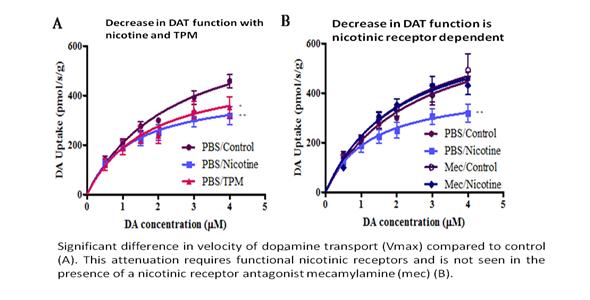Reports of research work funded by grants prior to 2012
Victoria University of Wellington
Investigating the Contribution of the Minor Tobacco Alkaloids to Neuroadaptations in Smoking Addiction
B Kivell, K Danielson and F Putt
School of Biological Sciences,
Penny Truman, Environmental Scientific Research (ESR)
Cigarette smoking results in over 5000 deaths per year in New Zealand alone. Nicotine replacement therapy is the most common form of smoking cessation therapy, but this is only marginally effective with approximately 10% success over one year. This has led us to investigate the contribution of non-nicotinic components of tobacco smoke in smoking addiction.
Smoking causes the release of neurotransmitters in the brain including dopamine and serotonin. Dopamine activates the natural reward pathway in the brain and serotonin is involved in the regulation of mood, memory and motivation. The dopamine transporter (DAT) and serotonin transporter (SERT) function to remove dopamine and serotonin from the synapse, thus terminating their signalling. There have been surprisingly few studies that have investigated the effects of nicotine and cigarette smoking on DAT and SERT. This study has built on work previously conducted in our laboratory into the effects of nicotine and total particulate matter (TPM) of cigarette smoke on DAT and SERT expression and function.
The aim of this study is to assess the possible contribution of TPM and minor tobacco alkaloids in smoking addiction.
We have shown that nicotine (0.35 mg/kg) and TPM (containing the same amount of nicotine) decrease DAT function in the nucleus accumbens 30 min following treatment (Figure 1A). This change was not due to a decrease in DAT protein or mRNA expression. Kinetic data showed that for both nicotine and TPM there was a decrease in dopamine transporter velocity (69.4% and 82.1% of control respectively), with no change in binding affinity. To test whether this decrease in function was nicotinic receptor-dependent, the non-specific nicotinic antagonist mecamylamine (MEC) (1.5 mg/kg i.p.) was administered. MEC treatment completely attenuated the decrease in DAT velocity for nicotine (Figure 1B) and TPM (data not shown). Nicotine and TPM have no effect on dopamine uptake in the striatum or prefrontal cortex, or serotonin uptake in the striatum at 30 min, suggesting that these effects are brain region specific. Further investigations into the nicotinic subunit responsible for these changes has shown that the nicotinic alpha 4 subunit, but not alpha 7 subunit, is responsible for these effects. DHβE inhibition of the alpla 4 subunit prevented the attenuation of DAT function; whereas, inhibition of the alpha 7 subunit with methyllycaconitine had no effect. This suggests that the attenuation of DAT function occures via the alpha 4 subunit of the nicotinic acetylcholine receptor.
Preliminary studies into the effects of the minor tobacco alkaloids anabasine, nornicotine, anatabine, cotinine, and myosmine have shown no change in DAT function ex vivo following 30 and 60 minute treatments using RDEV neurochemistry techniques (n=3).
Findings from this research will be presented at the 30th Meeting of the Australasian Winter Conference on Brain Research in Queenstown (August - 2012). Ongoing research will continue to investigate the role of minor tobacco alkaloids in smoking addiction and identify the signalling mechanisms regulating monoamine transporter function. Our long-term aim is to find new therapeutic targets for smoking addiction.
Figure 1.




